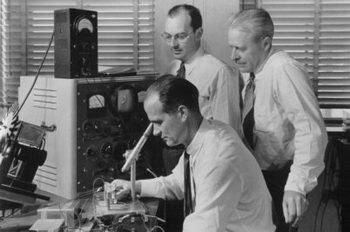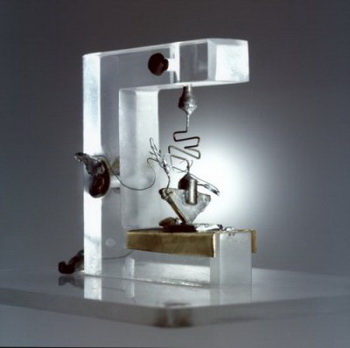OOPS! You forgot to upload swfobject.js ! You must upload this file for your form to work.
Transistor turns 65
![]()
|
xtreview is your : Video card - cpu - memory - Hard drive - power supply unit source |
|
|||
|
|
||||
 Recommended : Free unlimited image hosting with image editor
Recommended : Free unlimited image hosting with image editor
|
POSTER: computer news || TRANSISTOR TURNS 65 |
DATE:2012-12-17 |
|
|
Sixty-five years ago, on 16 December 1947, researchers at Bell Labs, William Shockley (William Shockley), John Bardeen (John Bardeen) and Walter Brattain (Walter Brattain) first demonstrated the operation of a bipolar transistor. Official presentation took place a week later, on 23 December.  The transistor was the evolution of an electron tube, but it had no moving parts, filaments and vacuum. In addition, the transistor does not require time to warm up, and it could be operated much more often. The popularity of transistor came after it became the base for the radio series, issued by Texas Instruments in 1958. In 1958, a group of researchers, which included Intel founder Robert Noyce (Robert Noyce) managed to place two transistors on the same substrate, creating the first integrated circuit. Six years later, Gordon Moore (Gordon Moore) - another scientist, who has spearheaded Intel, expressed the notorious theory of doubling the number of transistors on a substrate every two years.  Today's microprocessors include billions of transistors. They are safe to be called the building blocks of all semiconductor technology. At present, the industry is on the rise - every day there are new materials and technologies directed at increasing speed and miniaturization of semiconductors. The transistor is considered one of the most rapidly evolving devices, and it is assumed that this rate it will continue to develop for another 10-15 years.
Related Products : | ||
|
|
||
|
xtreview is your : Video card - cpu - memory - Hard drive - power supply unit source |
|
|
|
|
||
|
Xtreview Support  N-Post:xxxx Xtreview Support        |
TRANSISTOR TURNS 65 |
| Please Feel Free to write any Comment; Thanks  |
Intel turns off on the direction of smart watches and bracelets (2017-07-21)
The motherboard Asus ROG Maximus IX Extreme turns itself off when a leakage of a coolant accure (2017-07-13)
X86 turns 40 (2017-06-10)
AMD returns to the server market with EPYC processors (2017-05-17)
Ubuntu 18.04 returns to the source (2017-04-07)
Swatch Cordless project does not promise quick returns (2016-12-23)
According to rumors, the new Resident Evil returns to the origins of the series (2016-05-18)
Cortana bug that turns off the microphone of the mobile device (2015-12-09)
Adobe Flash turns promotion in favor of HTML5 (2015-12-02)
Nokia returns to market with smartphones and virtual reality technology (2015-04-20)
Rambus returns (2015-01-31)
Scanadu turns the iPhone into a device for measuring temperature, pressure, heart rate and biochemical analysis (2015-01-12)
Sony SmartEyeglass Attach device that turns any points in smart (2015-01-06)
Nokia Lumia turns to Microsoft Lumia (2014-10-22)
Microsoft turns to develop Android-smartphone Nokia X (2014-07-17)
Access point Wi-Fi, open on your phone turns it into a distress beacon. (2014-02-28)
Sony turns off activity in the segment of e-books in North America (2014-02-07)
ASML turns working off the transition to silicon wafers size 450 mm (2013-12-22)
One of the pioneers segment ARM-server turns off its activities (2013-12-20)
Transistor turns 65 (2012-12-17)
![]()
To figure out your best laptops .Welcome to XTreview.com. Here u can find a complete computer hardware guide and laptop rating .More than 500 reviews of modern PC to understand the basic architecture


7600gt review
7600gt is the middle card range.
We already benchmarked this video card and found that ...

 geforce 8800gtx and 8800gts
geforce 8800gtx and 8800gts  Xtreview software download Section
Xtreview software download Section  AMD TURION 64 X2 REVIEW
AMD TURION 64 X2 REVIEW  INTEL PENTIUM D 920 , INTEL PENTIUM D 930
INTEL PENTIUM D 920 , INTEL PENTIUM D 930  6800XT REVIEW
6800XT REVIEW  computer hardware REVIEW
computer hardware REVIEW  INTEL CONROE CORE DUO 2 REVIEW VS AMD AM2
INTEL CONROE CORE DUO 2 REVIEW VS AMD AM2  INTEL PENTIUM D 805 INTEL D805
INTEL PENTIUM D 805 INTEL D805  Free desktop wallpaper
Free desktop wallpaper  online fighting game
online fighting game  Xtreview price comparison center
Xtreview price comparison center Lastest 15 Reviews


Rss Feeds
Last News
- The new version of GPU-Z finally kills the belief in the miracle of Vega transformation
- The motherboard manufacturer confirms the characteristics of the processors Coffee Lake
- We are looking for copper coolers on NVIDIA Volta computing accelerators
- Unofficially about Intels plans to release 300-series chipset
- The Japanese representation of AMD offered monetary compensation to the first buyers of Ryzen Threadripper
- This year will not be released more than 45 million motherboards
- TSMC denies the presentation of charges from the antimonopoly authorities
- Radeon RX Vega 64 at frequencies 1802-1000 MHz updated the record GPUPI 1B
- AMD itself would like to believe that mobile processors Ryzen have already been released
- AMD Vega 20 will find application in accelerating computations
- Pre-orders for new iPhone start next week
- Radeon RX Vega 57, 58 and 59: the wonders of transformation
- ASML starts commercial delivery of EUV-scanners
- The older Skylake processors with a free multiplier are removed from production
- Meizu will release Android-smartphone based on Helio P40
- AMD Bristol Ridge processors are also available in American retail
- The fate of Toshiba Memory can be solved to the next environment
- duo GeForce GTX 1080 Ti in GPUPI 1B at frequencies of 2480-10320 MHz
- New Kentsfield overclocking record up to 5204 MHz
- Lenovo released Android-smartphone K8

HALO 3 HALO 3 - Final Fight!

PREY Prey is something you don t often see anymore: a totally unigue shooter experience.

computer news computer parts review Old Forum Downloads New Forum Login Join Articles terms Hardware blog Sitemap Get Freebies


